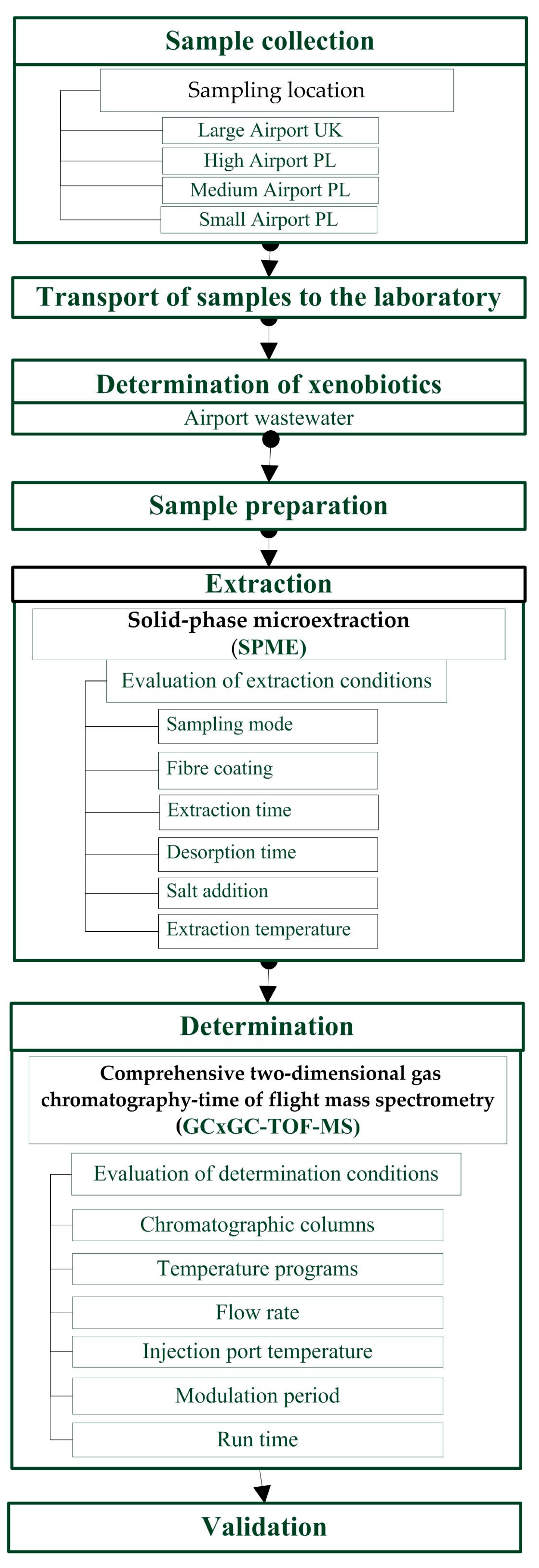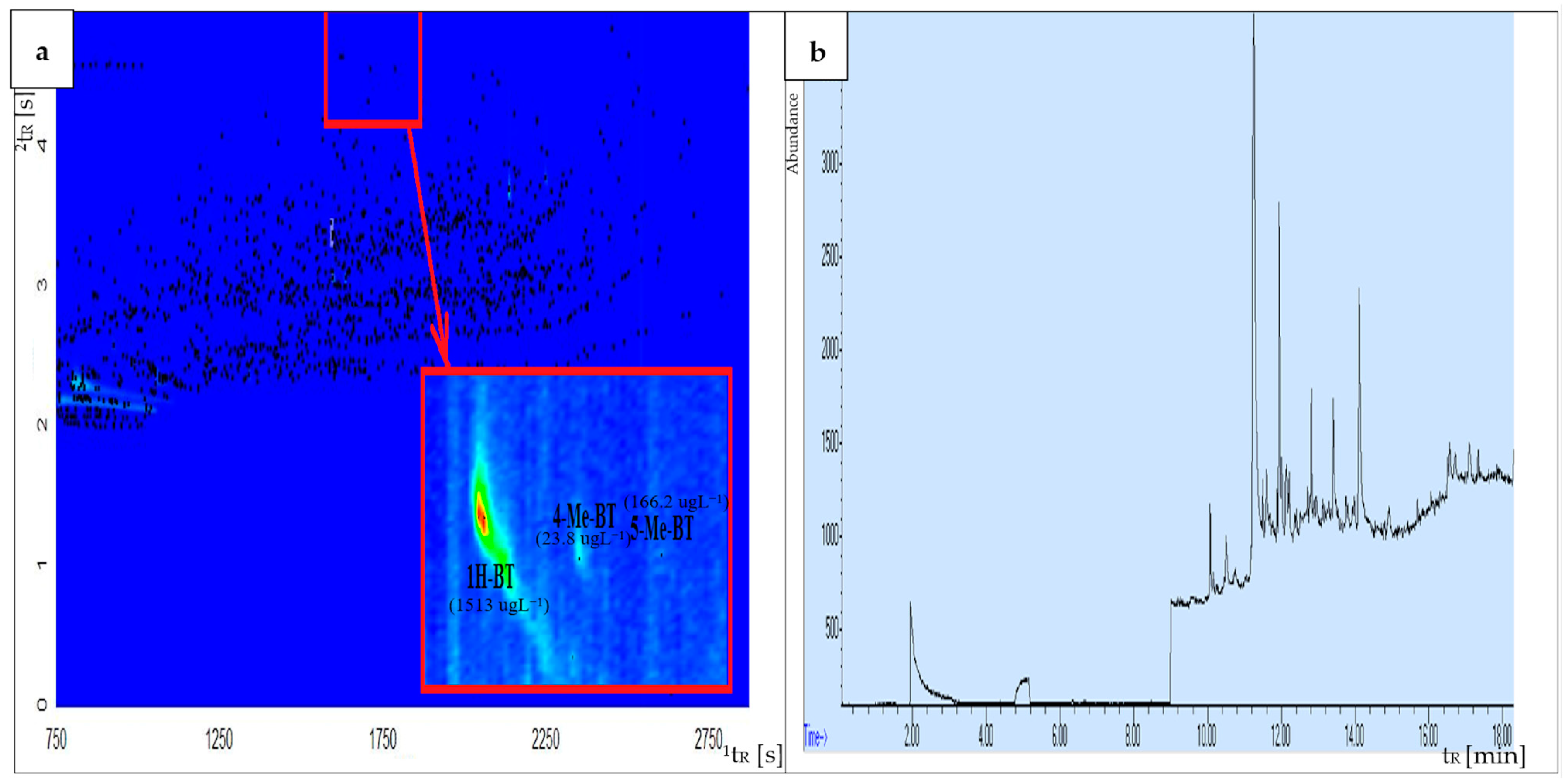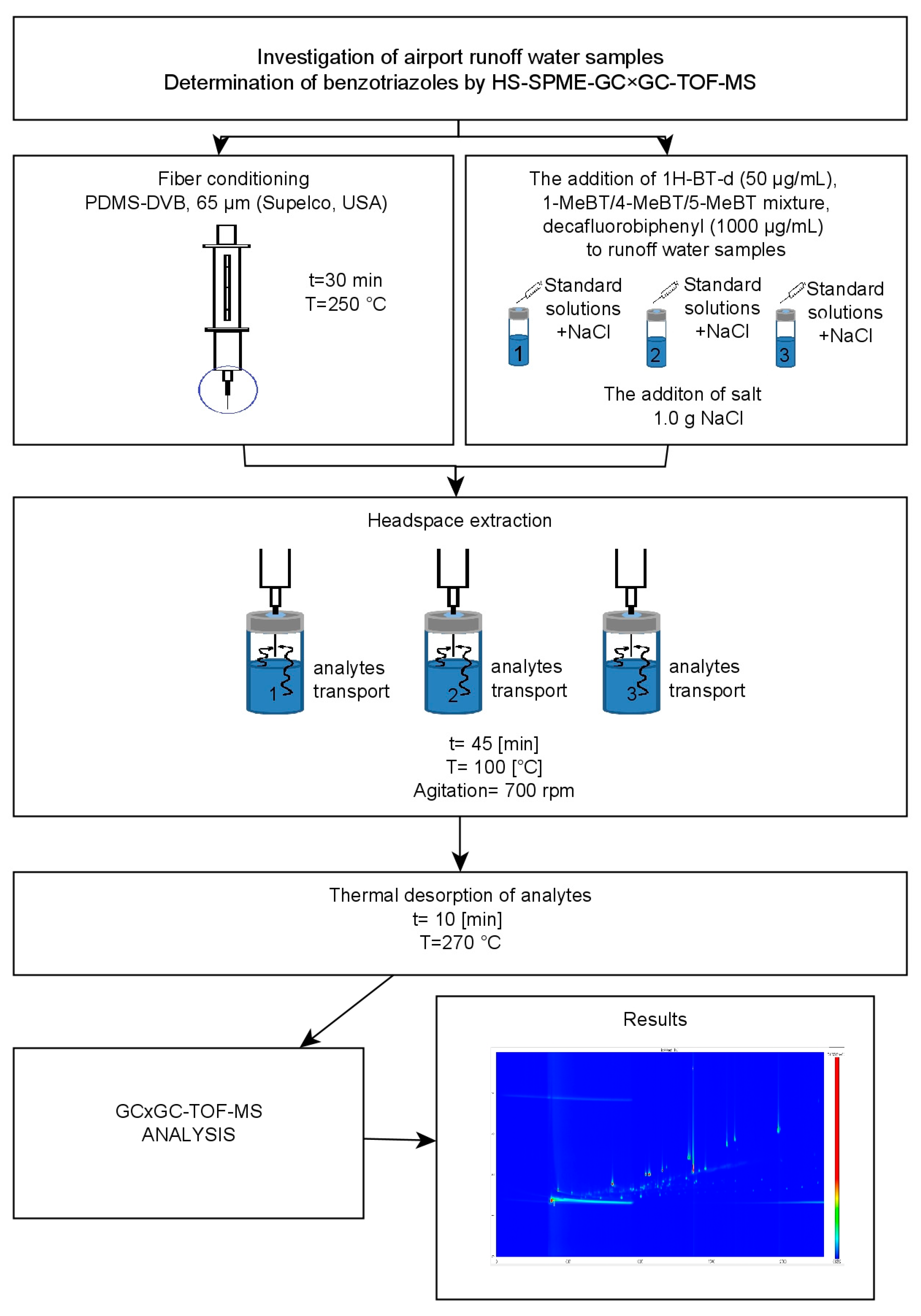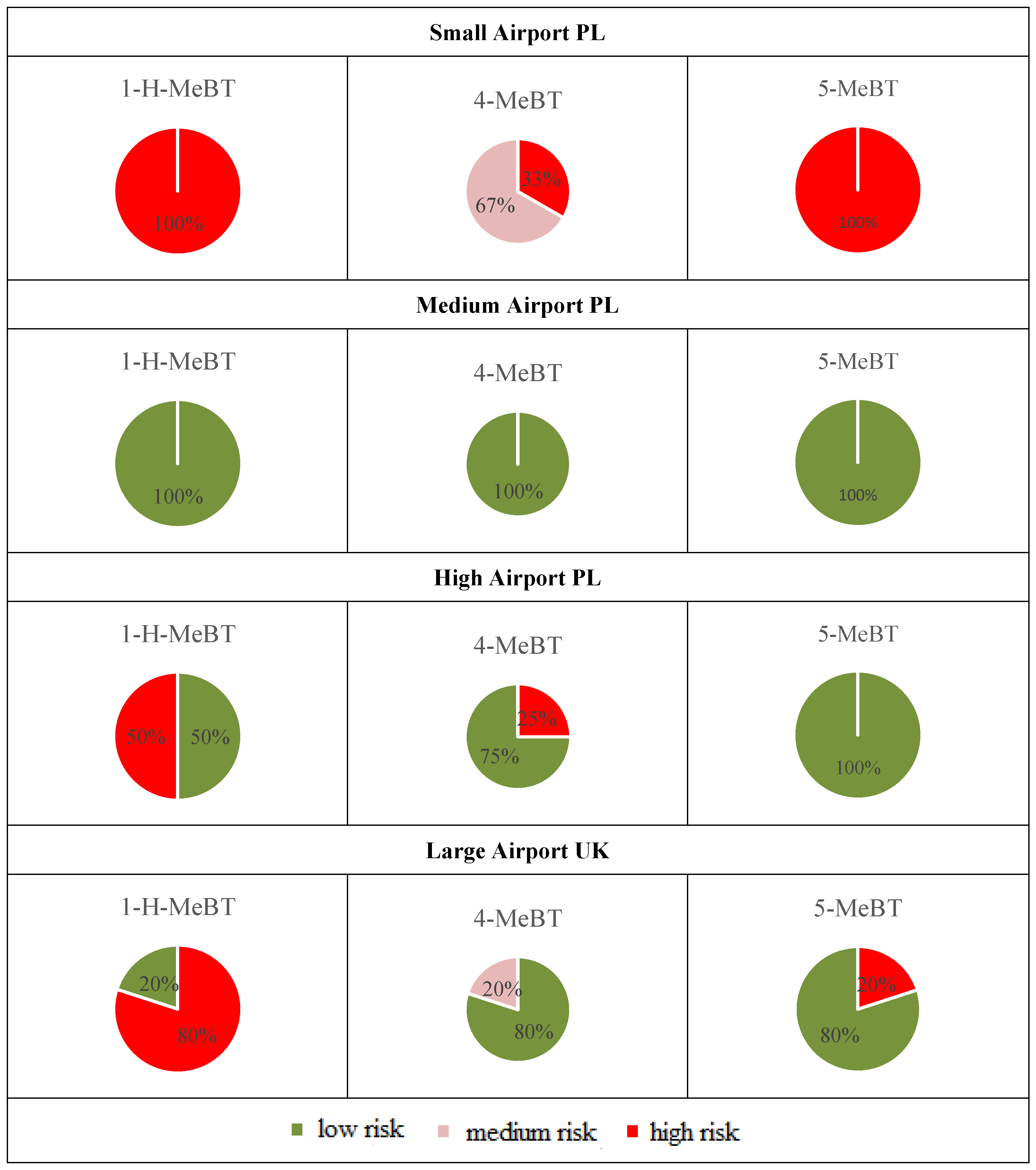Comprehensive Analysis and Environmental Risk Assessment of Benzotriazoles in Airport Stormwater: A HS-SPME-GC × GC-TOF-MS-Based Procedure as a Tool for Sustainable Airport Runoff Water Management
Abstract
1. Introduction
2. Materials and Methods
2.1. Airport Runoff Water Samples
2.2. Development of Analytical Procedures
2.2.1. Sample Preparation
2.2.2. GC × GC-TOF-MS Analysis
2.2.3. Quality Assurance/Quality Control (QA/QC)
2.2.4. Statistical Analysis
2.2.5. Evaluation of the Ecotoxicological Risk
3. Results and Discussion
3.1. Optimization of the Extraction Procedure
3.1.1. Selection of the Sampling Mode and Fiber Coating
3.1.2. Effects of Extraction Time
3.1.3. Effects of Ionic Strength
3.1.4. Effects of Extraction Temperature
3.1.5. Effects of Desorption Time
3.2. GC × GC-TOF-MS Analysis
3.3. Quality Assurance/Quality Control (QA/QC)
3.4. Environmental Application
3.5. The Ecotoxicological Risk of BTs
4. Conclusions
Supplementary Materials
Author Contributions
Funding
Institutional Review Board Statement
Informed Consent Statement
Data Availability Statement
Acknowledgments
Conflicts of Interest
References
- Kiss, A.; Fries, E. Occurence of benzotriazoles in the rivers Main, Hengstbach, and Hegbach (Germany). Environ. Sci. Pollut. Res. 2009, 16, 702–710. [Google Scholar] [CrossRef] [PubMed]
- Mohiley, A.; Franzaring, J.; Calvo, O.C.; Fangmeier, A. Potential toxic effects of aircraft de-icers and wastewater samples containing these compounds. Environ. Sci. Pollut. Res. 2015, 22, 13094–13101. [Google Scholar] [CrossRef] [PubMed]
- Iavicoli, I.; Chiarotti, M.; Bergmaschi, A.; Marsili, R. Determination of airborne polycyclic aromatic hydrocarbons at an airport by gas chromatography-mass spectrometry and evaluation of occupational exposure. J. Chromatogr. A 2007, 1150, 226–235. [Google Scholar] [CrossRef] [PubMed]
- Zhelnovach, G.; Belokon, K.; Barabash, O.; Dychko, A. Airport Runoff Management: Engineering Solutions. Ecol. Eng. Environ. Technol. 2022, 23, 230–240. [Google Scholar] [CrossRef] [PubMed]
- Peng, J.; Yu, L.; Zhong, X.; Dong, T. Study on Runoff Control Effect of Different Drainage Schemes in Sponge Airport. Water Resour. Manag. 2022, 36, 1043–1055. [Google Scholar] [CrossRef]
- Peng, J.; Wang, Q.Q.; Yang, X.S.; Yu, L.; Zhong, X. Application and evaluation of LID facilities in sponge airport, China. Water Sci. Technol. 2022, 85, 756–768. [Google Scholar]
- Rodziewicz, J.; Mielcarek, A.; Janczukowicz, W.; Bryszewski, K.; Ostrowska, K. Treatment of wastewater containing runway de-icing agents in biofilters as a part of airport environment management system. Sustainability 2020, 12, 3608. [Google Scholar] [CrossRef]
- Wang, Y.; Xie, X.; Liang, S.; Zhu, B.; Yao, Y.; Meng, S.; Lu, C. Quantifying the response of potential flooding risk to urban growth in. Sci. Total Environ. 2020, 705, 135868. [Google Scholar] [CrossRef]
- Corsi, S.R.; Zitomer, D.J.; Field, J.; Cancilla, D.A. Nonylphenol Ethoxylates and Other Additives in Aircraft Deicers, Antiicers, and Waters Receiving Airport Runoff. Environ. Sci. Technol. 2003, 37, 4031–4037. [Google Scholar] [CrossRef] [PubMed]
- Corsi, S.R.; Geis, S.W.; Bowman, G.; Failey, G.; Di Rutter, T. Aquatic Toxicity of Airfield-Pavement Deicer Materials and Implications for Airport Runoff. Environ. Sci. Technol. 2009, 43, 40–46. [Google Scholar] [CrossRef]
- Calvo, O.C.; Quaglia, G.; Mohiley, A.; Cesarini, M.; Fangmeier, A. Assessing potential aquatic toxicity of airport runoff using physicochemical parameters and Lemna gibba and Aliivibrio fischeri bioassays. Environ. Sci. Pollut. Res. 2020, 27, 40604–40617. [Google Scholar] [CrossRef]
- Magomedova, D.S.; Alimirzayeva, Z.M.; Magomedova, A.G.; Isaev, A.B.; Kharlamova, T.A. Electrochemical Treatment of Airport Runoff Water Containing Ethylene Glycol. Chem. Probl. 2022, 20, 109–115. [Google Scholar] [CrossRef]
- Pressl, A.; Pucher, G.; Scharf, B.; Langergraber, G. Treatment of de-icing contaminated surface water runoff along an airport runway using in-situ soil enriched with structural filter materials. Sci. Total Environ. 2019, 660, 321–328. [Google Scholar] [CrossRef]
- Corsi, S.R.; Harwell, G.R.; Geis, S.W.; Bergman, D. Impacts of aircraft deicer and anti-icer runoff on receiving waters from dallas/Fort Worth Intrnational Airport, Texas, USA. Environ. Toxicol. Chem. 2006, 25, 2890–2900. [Google Scholar] [CrossRef]
- Milley, S.A.; Koch, I.; Fortin, P.; Archer, J.; Reynolds, D.; Weber, K.P. Estimating the number of airports potentially contaminated with perfluoroalkyl and polyfluoroalkyl substances from aqueous film forming foam: A Canadian example. J. Environ. Manag. 2018, 222, 122–131. [Google Scholar] [CrossRef]
- Barash, S.; Covington, J.; Tamulonis, C. Preliminary Data Summary Airport Deicing Operations (Revised); United States Environmental Protection Agency: Washington, DC, USA, 2000; Volume 4303.
- Hartwell, S.I.; Jordahl, D.M.; Evans, J.E.; May, E.B. Toxicity of aircraft de-icer and anti-icer solutions to aquatic organisms. Environ. Toxicol. Chem. 1995, 14, 1375–1386. [Google Scholar]
- Iervolino, I.; Accardo, D.; Tirri, A.E.; Pio, G.; Salzano, E. Quantitative risk analysis for the Amerigo Vespucci (Florence, Italy) airport including domino effects. Saf. Sci. 2019, 113, 472–489. [Google Scholar] [CrossRef]
- Nguyen, M.A.; Norström, K.; Wiberg, K.; Gustavsson, J.; Josefsson, S.; Ahrens, L. Seasonal trends of per- and polyfluoroalkyl substances in river water affected by fire training sites and wastewater treatment plants. Chemosphere 2022, 308, 136467. [Google Scholar] [CrossRef]
- De Roos, A.J.; Kondo, M.C.; Robinson, L.F.; Rai, A.; Ryan, M.; Haas, C.N.; Lojo, J.; Fagliano, J.A. Heavy precipitation, drinking water source, and acute gastrointestinal illness in Philadelphia, 2015–2017. PLoS ONE 2020, 15, e0229258. [Google Scholar] [CrossRef] [PubMed]
- Grant, S. A Review of the Contaminants and Toxicity Associated with Particles in Stormwater Runoff. 2015. Available online: https://www.researchgate.net/publication/282219595_A_Review_of_the_Contaminants_and_Toxicity_Associated_with_particles_in_Stormwater_Runoff (accessed on 28 April 2024).
- Voutsa, D.; Hartmann, P.; Schaffner, C.; Giger, W. Benzotriazoles, alkylphenols and bisphenol A in municipal wastewaters and in the Glatt River, Switzerland. Environ. Sci. Pollut. Res. 2006, 13, 333–341. [Google Scholar] [CrossRef] [PubMed]
- Tan, B.; Guo, L.; Yin, D.; Ma, T.; Zhang, S.; Wang, C. Environmentally sustainable corrosion inhibitors used for electronics industry. Environ. Sustain. Corros. Inhib. 2022, 359–381. [Google Scholar] [CrossRef]
- Olds, H.T.; Corsi, S.R.; Rutter, T.D. Benzotriazole concentrations in airport runoff are reduced following changes in airport deicer formulations. Integr. Environ. Assess. Manag. 2022, 18, 245–257. [Google Scholar] [CrossRef] [PubMed]
- Cantwell, M.G.; Sullivan, J.C.; Burgess, R.M. Benzotriazoles: History, Environmental Distribution, and Potential Ecological Effects. Compr. Anal. Chem. 2015, 67, 513–545. [Google Scholar]
- Global Industry Analysts, Inc. Benzotriazole: Global Strategic Business Report. 2022. Available online: https://www.researchandmarkets.com/reports/5301677/benzotriazole-global-strategic-business-report (accessed on 28 April 2024).
- Alotaibi, M.D.; McKinley, A.J.; Patterson, B.M.; Reeder, A.Y. Benzotriazoles in the Aquatic Environment: A Review of Their Occurrence, Toxicity, Degradation and Analysis. Water. Air. Soil Pollut. 2015, 226, 226. [Google Scholar] [CrossRef]
- Kotowska, U.; Sokołowska, J.S.; Piekutin, J. Simultaneous determination of low molecule benzotriazoles and benzotriazole UV stabilizers in wastewater by ultrasound—Assisted emulsification microextraction followed by GC–MS detection. Sci. Rep. 2021, 11, 10098. [Google Scholar] [CrossRef] [PubMed]
- Krautsieder, A.; Sharifi, N.; Madden, D.C.; Sonke, J.; Routh, A.F.; Clarke, S.M. Corrosion inhibitor distribution on abrasive-blasted steels. J. Colloid Interface Sci. 2023, 634, 336–345. [Google Scholar] [CrossRef] [PubMed]
- Asimakopoulos, A.G.; Wang, L.; Thomaidis, N.S.; Kannan, K. Benzotriazoles and benzothiazoles in human urine from several countries: A perspective on occurrence, biotransformation, and human exposure. Environ. Int. 2013, 59, 274–281. [Google Scholar] [CrossRef] [PubMed]
- Cottin, G.; Houde, M.; Giraudo, M. Transcriptomic, cellular and life-history responses of Daphnia magna chronically exposed to benzotriazoles: Endocrine-disrupting potential and molting effects. PLoS ONE 2017, 12, e0171763. [Google Scholar] [CrossRef] [PubMed]
- Pillard, D.; Dufresne, D.; Hernandez, M. Toxicity of benzotriazole and benzotriazole derivatives to three aquatic species. Water Res. 2001, 35, 557–560. [Google Scholar] [CrossRef]
- Corsi, S.; Geis, S.W.; Rice, C.; Sheesley, R. Characterization of Aircraft Deicer and Anti-Icer Components and Toxicity in Airport Snowbanks and Snowmelt Runoff. Environ. Sci. Technol. 2006, 40, 3195–3202. [Google Scholar] [CrossRef]
- Sulej, A.M.; Polkowska, Z.; Astel, A.; Namieśnik, J. Analytical procedures for the determination of fuel combustion products, anti-corrosive compounds, and de-icing compounds in airport runoff water samples. Talanta 2013, 117, 158–167. [Google Scholar] [CrossRef] [PubMed]
- Tangtian, H.; Bo, L.; Wenhua, L.; Paul, K.S.; Shin, R.S.S.W. Estrogenic potential of benzotriazole on marine medaka (Oryzias melastigma). Ecotoxicol. Environ. Saf. 2012, 80, 327–332. [Google Scholar] [CrossRef] [PubMed]
- Shi, Z.Q.; Liu, Y.S.; Xiong, Q.; Cai, W.W.; Ying, G.G. Occurrence, toxicity and transformation of six typical benzotriazoles in the environment: A review. Sci. Total Environ. 2019, 661, 407–421. [Google Scholar] [CrossRef] [PubMed]
- Pinto, J. ScienceDirect Micro- and nanoplastics in the environment: Research and policymaking. Curr. Opin. Environ. Sci. Health 2018, 1, 12–16. [Google Scholar]
- Zhou, Y.; Qu, J.; Liu, W.; Liao, J.; Li, Y.; Zhao, H.; Li, J.; Jin, H.; Liu, H.; Fang, J.; et al. Early pregnancy exposure to benzotriazoles and benzothiazoles in relation to gestational diabetes mellitus: A prospective cohort study. Environ. Int. 2020, 135, 105360. [Google Scholar] [CrossRef] [PubMed]
- Cancilla, D.A.; Holtkamp, A.; Matassa, L.; Fang, X. Isolation and characterization of Microtox®-active components from aircraft de-icing/anti-icing fluids. Environ. Toxicol. Chem. 1997, 16, 430–434. [Google Scholar]
- Cancilla, D.A.; Martinez, J.; Van Aggelen, G.C. Detection of aircraft De-icing/Antiicing Fluid Additives in a Perched Water Monitoring Well at an International Airport. Environ. Sci. Technol. 1998, 32, 3834–3835. [Google Scholar] [CrossRef]
- Snow, N.H. Chapter 8—Applications. Sep. Sci. Technol. 2020, 12, 269–295. [Google Scholar]
- Sulej-Suchomska, A.M.; Polkowska, Ż.; Chmiel, T.; Dymerski, T.M.; Kokot, Z.J.; Namieśnik, J. Solid phase microextraction-comprehensive two-dimensional gas chromatography-time-of-flight mass spectrometry: A new tool for determining PAHs in airport runoff water samples. Anal. Methods 2016, 8, 4509–4520. [Google Scholar] [CrossRef]
- Ieda, T.; Ochiai, N.N.; Miyawaki, T.; Ohura, T.; Horii, Y. Environmental analysis of chlorinated and brominated polyciclic aromatic hydrocarbons by comprehensive two-dimentional gas chromatography coupled to high-resolution time-of-flight mass spectrometry. J. Chromatogr. A 2011, 1218, 3224–3232. [Google Scholar] [CrossRef]
- Frysinger, G.S.; Gaines, R.B.; Reddy, C.M. GC × GC—A new analytical tool for environmental forensics. Environ. Forensics 2002, 3, 27–34. [Google Scholar]
- Pani, O.; Górecki, T. Comprehensive two-dimensional gas chromatography (GC × GC) in environmental analysis and monitoring. Anal. Bioanal. Chem. 2006, 386, 1013–1023. [Google Scholar] [CrossRef] [PubMed]
- Mladenov, N.; Dodder, N.G.; Steinberg, L.; Richardot, W.; Johnson, J.; Martincigh, B.S.; Buckley, C.; Lawrence, T.; Hoh, E. Persistence and removal of trace organic compounds in centralized and decentralized wastewater treatment systems. Chemosphere 2022, 286, 131621. [Google Scholar] [CrossRef] [PubMed]
- Stefanuto, P.H.; Smolinska, A.; Focant, J.F. Advanced chemometric and data handling tools for GC × GC-TOF-MS: Application of chemometrics and related advanced data handling in chemical separations. Trends Anal. Chem. 2021, 139, 116251. [Google Scholar] [CrossRef]
- Fischer, K.; Fries, E.; Körner, W.; Schmalz, C.; Zwiener, C. New developments in the trace analysis of organic water pollutants. Appl. Microbiol. Biotechnol. 2012, 94, 11–28. [Google Scholar] [CrossRef] [PubMed]
- Vaye, O.; Ngumbu, R.S.; Xia, D. A review of the application of comprehensive two-dimensional gas chromatography MS-based techniques for the analysis of persistent organic pollutants and ultra-trace level of organic pollutants in environmental samples. Rev. Anal. Chem. 2022, 41, 63–73. [Google Scholar] [CrossRef]
- Struk-Sokołowska, J.; Gwoździej-Mazur, J.; Jurczyk, Ł.; Jadwiszczak, P.; Kotowska, U.; Piekutin, J.; Canales, F.A.; Kaźmierczak, B. Environmental risk assessment of low molecule benzotriazoles in urban road rainwaters in Poland. Sci. Total Environ. 2022, 839, 156246. [Google Scholar] [CrossRef] [PubMed]
- Zhao, M.-L.; Chen, Y.; Yang, G.-P.; Chen, R. Simultaneous determination of benzothiazoles, benzotriazoles, and benzotriazole UV absorbers by solid-phase extraction-gas chromatography-mass spectrometry. Environ. Sci. Pollut. Res. 2023, 30, 45315–45330. [Google Scholar] [CrossRef] [PubMed]
- Carpinteiro, I.; Abuín, B.; Rodríguez, I.; Cela, R.; Ramil, M. Headspace solid-phase microextraction followed by gas chromatography tandem mass spectrometry for the sensitive determination of benzotriazole UV stabilizers in water samples. Anal. Bioanal. Chem. 2010, 397, 829–839. [Google Scholar] [CrossRef]
- Zhang, Z.-M.; Zhang, H.-H.; Zhang, J.; Wang, Q.-W.; Yang, G.-P. Occurrence, distribu_tion, and ecological risks of phthalate esters in the seawater and sediment of Changjiang River estuary and its adjacent area. Sci. Total Environ. 2018, 619–662, 93–102. [Google Scholar] [CrossRef]
- Perrodin, Y.; Boillot, C.; Angerville, R.; Donguy, G.; Emmanual, E. Ecological risk as_sessment of urban and industrial systems: A review. Sci. Total Environ. 2011, 409, 5162–5176. [Google Scholar] [CrossRef] [PubMed]
- EU. Technical Guidance Document (TGD) in Support of Com_mission Directive 93/67/EEC on Risk Assessment for New Notified Substances, Commis_sion Regulation (EC) No 1488/94 on Risk Assessment for Existing Substances and Directive 98/8/EC of the European. Publications Office of the European Union. 2003. Available online: https://op.europa.eu/en/publication-detail/-/publication/212940b8-3e55-43f8-8448-ba258d0374bb/language-en (accessed on 28 April 2024).
- Directive 2000/60/EC of the European Parliament and of the Council, Establishing a Framework for Community Action in the Field of Water Policy. 2000. Available online: https://www.eea.europa.eu/policy-documents/directive-2000-60-ec-of (accessed on 28 April 2024).
- Damalas, D.E.; Bletsou, A.A.; Agalou, A.; Beis, D.; Thomaidis, N.S. Assessment of the acute toxicity, uptake and biotransformation potential of benzotriazoles in zebrafish (Danio rerio) larvae combining HILIC- with RPLC-HRMS for high-throughput identifica_tion. Environ. Sci. Technol. 2018, 52, 6023–6031. [Google Scholar] [CrossRef]
- Seeland, A.; Oetken, M.; Kiss, A.; Fries, E.; Oehlmann, J. Acute and chronic toxicity of benzotriazoles to aquatic organisms. Environ. Sci. Pollut. Res. 2012, 19, 1781–1790. [Google Scholar] [CrossRef] [PubMed]
- Hart, D.S.; Davis, L.C.; Erickson, L.E.; Callender, T.M. Sorption and partitioning parameters of benzotriazole compounds. Microchem. J. 2004, 77, 9–17. [Google Scholar] [CrossRef]
- Pawliszyn, J. Handbook of Sample Preparation; John Wiley & Sons, Inc.: Hoboken, NJ, USA, 2010. [Google Scholar]
- Pawliszyn, J. 1—Solid-Phase Microextraction in Perspective. In Handbook of Solid Phase Microextraction; Pawliszyn, J., Ed.; Elsevier: Amsterdam, The Netherlands, 2012; pp. 1–12. [Google Scholar] [CrossRef]
- Spietelun, A.; Kloskowski, A.; Chrzanowski, W.; Namieśnik, J. Understanding solid-phase microextraction: Key factors influencing the extraction process and trends in improving the technique. Chem. Rev. 2013, 113, 1667–1685. [Google Scholar] [CrossRef] [PubMed]
- Merkle, S.; Kleeberg, K.K.; Fritsche, J. Recent Developments and Applications of Solid Phase Microextraction (SPME) in Food and Environmental Analysis—A Review. Chromatography 2015, 2, 293–381. [Google Scholar] [CrossRef]
- Płotka-Wasylka, J.; Małgorzata, R.; Namieśnik, J. Solid Phase Microextraction: State of the Art, Opportunities and Applications; Nova Science Publishers, Inc.: Hauppauge, NY, USA, 2017. [Google Scholar]
- Han, L.; Jiang, S.; Wang, Q. Application of a single-drop microextraction for the analysis of organophosphorus pesticides in juice. J. Chromatogr. A 2006, 1114, 269–273. [Google Scholar]
- Barros, E.P.; Moreira, N.; Pereira, G.E.; Leite SG, F.; Rezende, C.M.; de Pinho, P.G. Development and validation of automatic HS-SPME with a gas chromatography-ion trap/mass spectrometry method for analysis of volatiles in wines. Talanta 2012, 101, 177–186. [Google Scholar] [CrossRef] [PubMed]
- Zhang, Z.; Pawliszyn, J. Headspace solid phas microextraction. Anal. Chem. 1993, 65, 1843. [Google Scholar] [CrossRef]
- Costas, M.; Pena-Pereira, F.J. Method Development with Miniaturized Sample Preparation Techniques 6 Method Development with Miniaturized Sample Preparation Techniques; De Gruyter Open Ltd.: Warsaw, Poland; Berlin, Germany, 2015. [Google Scholar]
- Sulej-Suchomska, A.M.; Polkowska, Z.; Kokot, Z.J.; de la Guardia, M.; Namieśnik, J. Determination of antifreeze substances in the airport runoff waters by solid-phase microextraction and gas chromatography-mass spectrometry method. Microchem. J. 2016, 126, 466–473. [Google Scholar] [CrossRef]
- Marriott, P.; Shellie, R. Principles and applications of comprehensivetwo-dimensional gas chromatography. Trends Anal. Chem. 2002, 21, 9–10. [Google Scholar] [CrossRef]
- Skoczyńska, E.; Korytar, P.; Boer, J. Maximilizing Chromatographic Information from Environmental Extracts by GC × GC-TOF-MS. Environ. Sci. Technol. 2008, 42, 6611–6618. [Google Scholar] [CrossRef]
- Breedveld, G.D.; Roseth, R.; Sparrevik, M.; Hartnik, T.; Hem, L.J. Persistence of the de-icing additive benzotriazole at an abandoned airport. Water Air Soil Pollut. 2003, 3, 91–101. [Google Scholar] [CrossRef]
- Kale, U.; Jankovics, I.; Nagy, A.; Rohács, D. Towards sustainability in air traffic management. Sustainability 2021, 13, 5451. [Google Scholar] [CrossRef]
- Xiong, C.; Beckmann, V.; Tan, R. Effects of infrastructure on land use and land cover change (LUCC): The case of Hangzhou international airport, China. Sustainability 2018, 10, 2013. [Google Scholar] [CrossRef]
- EPA. Part 122—EPA Administered Permit Programs: The National Pollutant Discharge Elimination System. 33 U.S.C. 1251. Available online: https://www3.epa.gov/npdes/pubs/cafo_part122.pdf (accessed on 28 April 2024).
- ICAO. Water Management at Airports. 2019. Available online: https://www.icao.int/environmental-protection/Documents/Water%20management%20at%20airports.pdf (accessed on 28 April 2024).
- Jaiyeola, A.T. The management and treatment of airport rainwater in a water-scarce environment. Int. J. Environ. Sci. Technol. 2017, 14, 421–434. [Google Scholar] [CrossRef]
- Brtnický, M.; Pecina, V.; Baltazár, T.; Vašinová Galiová, M.; Baláková, L.; Bęś, A.; Radziemska, M. Environmental Impact Assessment of Potentially Toxic Elements in Soils Near the Runway at the International Airport in Central Europe. Sustainability 2020, 12, 7224. [Google Scholar] [CrossRef]
- Surya, B.; Hamsina, H.; Ridwan, R.; Baharuddin, B.; Menne, F.; Fitriyah, A.T.; Rasyidi, E.S. The Complexity of Space Utilization and Environmental Pollution Control in the Main Corridor of Makassar City, South Sulawesi, Indonesia. Sustainability 2020, 12, 9244. [Google Scholar] [CrossRef]






| Equipments | SPME Fibre Holder (Supelco, Bellefonte, PA, USA); |
| SPME Fibre: Polydimethylsiloxane/Divinylbenzene (PDMS-DVB), 65 µm (Supelco, Bellefonte, PA, USA) | |
| Glass syringes with a capacity of 5 μL, 100 μL (Hamilton, Reno, NV, USA) | |
| Amber glass bottles, 1000 mL (Merck, Darmstadt, Germany) | |
| Automatic pipettes 10 μL, 100 μL, 1000 μL, 10 mL (Brand, Wertheim, Germany) | |
| Standard solutions | Mix of benzotriazoles (1-MeBT, 4-MeBT, 5-MeBT), 1000 μg mL−1 in methanol (Sigma-Aldrich, Seelze, Germany) |
| 5,6-dimethylo-1H-benzotriazole, 1000 μg/mL in methanol (Sigma-Aldrich, Seelze, Germany) | |
| 1H-benzotriazole-d4, 50 μg/mL(Sigma-Aldrich, Seelze, Germany) | |
| Decafluorobiphenyl, 1000 μg/mL in dichloromethane (Ultra-Scientific, N. Kingstown, RI, USA) | |
| Other | Liquid nitrogen (purity N6.0, Linde, Warsaw, Poland) |
| Helium (purity N6.0, Oxygen, Warsaw, Poland) | |
| Air (purity N5.5, Linde, Warsaw, Poland) | |
| Gaseous nitrogen (purity N5.0, Linde, Warsaw, Poland) | |
| NaCl (Merck, Darmstadt, Germany) | |
| Deionized water, Milli-Q (Millipore Corporation, Burlington, MA, USA) |
| Measurement Element/Parameter | Specifications and Conditions of the Analysis |
|---|---|
| Gas chromatograph | Agilent 7890A (Agilent Technologies, Palo Alto, CA, USA) |
| Detector | Pegasus 4D GC × GC (LECO Corporation, St. Joseph, MI, USA) equipped with a non-moving quad jet dual-stage cryomodulator |
| Autosampler | MPS (Gerstel, Germany); included fully automated SPME |
| Detector working mode | mass range 33–500 m/z |
| Ionization source temperature | 250 °C |
| Electron energy | 70 eV |
| Detector voltage | −1650 V |
| Chromatographic column I | ZB-5MS (Phenomenex, Torrance, USA; 30 m × 0.25 mm; 0.25 µm film) |
| Stationary phase of column I | 5/95 phenyl/polydimethylsiloxane |
| Temperature program (column I) | 65 °C (1 min); 65–250 °C (5 °C/min); 250 °C (10 min) |
| Carrier gas pressure | 1 × 10−7 bar |
| Carrier gas flow rate | 1 mL/min |
| Chromatographic column of column II | BPX50 (SGE Analytical Science, Crownhill, UK; 2 m × 0.1 mm; 0.1 µm film) |
| Stationary phase of column II | 50% Phenyl Polysilphenylene-siloxane |
| Temperature program (column II) | 75 °C (1 min); 75–260 °C (5 °C/min); 260 °C (10 min) |
| Injection port temperature | 270 °C |
| Transfer line temperature | 250 °C |
| Injection mode | splitless |
| Data acquisition rate | 200 Hz |
| Modulation period | 5 s |
| Hot pulse duration | 1 s |
| Modulator temperature offset | 30 °C |
| Analysis time | 48 min |
| Analytes/ Parameters | Linearity Range | Coefficient of Determination, R2 | MDL | MQL | Precision, CV | Recovery | |||||||||||
| Inter–day Precision | Intraday Precision | ||||||||||||||||
| I | II | III | I | II | III | Low 1 (D1–D3) 2 | Medium 1 (D1–D3) | High 1 (D1–D3) | Low | Medium | High | Low (D1–D3) | Medium (D1–D3) | High (D1–D3) | |||
| [μgL−1] | [μgL−1] | [%] | |||||||||||||||
| 1H-BT | 5.0–50 | 50–500 | 500–50,000 | 0.9899 | 0.9965 | 0.9967 | 0.0062 | 0.019 | 9.2–14.5 | 8.7–14.1 | 6.2–13.9 | 9.0 | 9.8 | 7.9 | 80.0–119.2 | 81.2–120.0 | 85.9–106.3 |
| 4-MeBT | 0.9909 | 0.9924 | 0.9931 | 0.0044 | 0.013 | 6.5–14.7 | 8.5–14.8 | 7.1–13.5 | 5.9 | 8.0 | 6.5 | 84.0–118.0 | 87.2–116.5 | 87.3–103.1 | |||
| 5-MeBT | 0.9925 | 0.9930 | 0.9920 | 0.0042 | 0.012 | 7.2–14.9 | 8.3–14.7 | 7.4–14.8 | 6.9 | 7.9 | 9.2 | 85.6–119.0 | 90.3–110.7 | 92.9–102.5 | |||
| 5,6-diMe-1H-BT | 0.9915 | 0.9964 | 0.9972 | 0.0051 | 0.018 | 8.9–14.5 | 9.4–14.3 | 8.7–14.5 | 8.5 | 9.2 | 7.6 | 81.0–116.0 | 83.5–107.9 | 89.9–107.4 | |||
Disclaimer/Publisher’s Note: The statements, opinions and data contained in all publications are solely those of the individual author(s) and contributor(s) and not of MDPI and/or the editor(s). MDPI and/or the editor(s) disclaim responsibility for any injury to people or property resulting from any ideas, methods, instructions or products referred to in the content. |
© 2024 by the authors. Licensee MDPI, Basel, Switzerland. This article is an open access article distributed under the terms and conditions of the Creative Commons Attribution (CC BY) license (https://creativecommons.org/licenses/by/4.0/).
Share and Cite
Sulej-Suchomska, A.M.; Koziol, K.; Polkowska, Ż. Comprehensive Analysis and Environmental Risk Assessment of Benzotriazoles in Airport Stormwater: A HS-SPME-GC × GC-TOF-MS-Based Procedure as a Tool for Sustainable Airport Runoff Water Management. Sustainability 2024, 16, 5152. https://doi.org/10.3390/su16125152
Sulej-Suchomska AM, Koziol K, Polkowska Ż. Comprehensive Analysis and Environmental Risk Assessment of Benzotriazoles in Airport Stormwater: A HS-SPME-GC × GC-TOF-MS-Based Procedure as a Tool for Sustainable Airport Runoff Water Management. Sustainability. 2024; 16(12):5152. https://doi.org/10.3390/su16125152
Chicago/Turabian StyleSulej-Suchomska, Anna Maria, Krystyna Koziol, and Żaneta Polkowska. 2024. "Comprehensive Analysis and Environmental Risk Assessment of Benzotriazoles in Airport Stormwater: A HS-SPME-GC × GC-TOF-MS-Based Procedure as a Tool for Sustainable Airport Runoff Water Management" Sustainability 16, no. 12: 5152. https://doi.org/10.3390/su16125152
APA StyleSulej-Suchomska, A. M., Koziol, K., & Polkowska, Ż. (2024). Comprehensive Analysis and Environmental Risk Assessment of Benzotriazoles in Airport Stormwater: A HS-SPME-GC × GC-TOF-MS-Based Procedure as a Tool for Sustainable Airport Runoff Water Management. Sustainability, 16(12), 5152. https://doi.org/10.3390/su16125152








